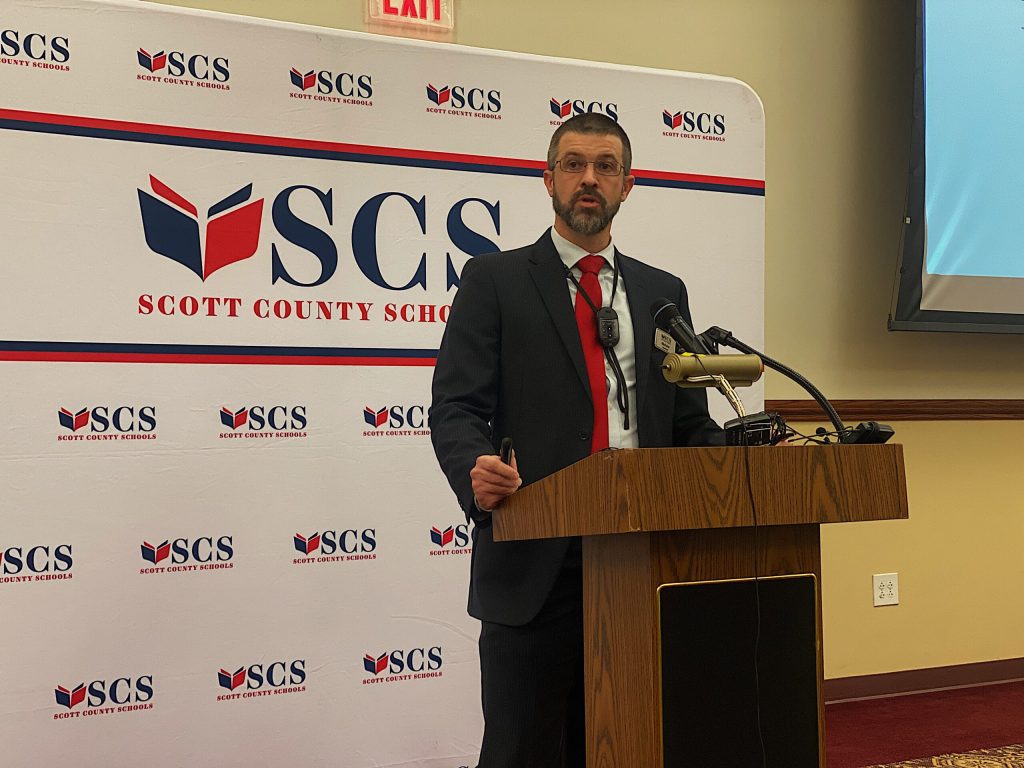Kentucky superintendents say they can’t provide fair raises or wages under proposed budget
Published 4:05 pm Wednesday, February 21, 2024

- Scott County Superintendent Billy Parker presents public school funding breakdown. (Photo by Gillian Stawiszynski)
|
Getting your Trinity Audio player ready...
|
Concerned central Kentucky Superintendents gathered at Scott County High School last week to hear a presentation by the hosting Scott County Superintendent Billy Parker on the impact of House Bill 6 on Raises for School Employees.
The House passed House Bill 6 (HB6) and is now in the Senate.
There is good in HB6, as explained by Parker, but this budget does not address raises for teachers and staff and, therefore, does not address the pre-existing and growing issue of the qualified teacher shortage.
Trending
In the governor’s budget, Gov. Andy Beshear proposed an 11 percent raise for school employees. Still, with HB6’s current language, all central Kentucky districts can provide about a two percent raise in the 24-25 school year and only about a zero to one percent raise in the 25-26 school year.
“I think this has been a significant time for superintendents to come together from central Kentucky so that we can have a united voice in helping our communities understand the potential implications as we look at the state budget that’s being proposed right now. And it is concerning, because as I do the calculations in Jessamine County with the proposal from the House, it really does only give us the ability to offer raises at 1.25 percent for our staff. I think that everyone would agree that their work is very demanding, and they deserve a larger raise than what is being proposed right now,” said Matt Moore, the superintendent of Jessamine County Schools.
Parker started the presentation by sharing his appreciation for Kentucky legislators during the meeting on Valentine’s Day.
The budget provides record investments in the TRS (Teachers Retirement System) pension program and the medical insurance trust fund. HB6 also maintains full-day Kindergarten funding.
HB6 would increase the overall Kentucky Department of Education budget by $484 million over a biennium, which will support an increase in the state portion of employee health insurance, an increase of the state portion of the TRS employer match, and support for the employee liability insurance that passed last session.
None of the above funding goes to the district and, therefore, can’t be used for teacher and staff salaries.
Trending
Facility Equalization Funding would also be increased by $43.1 million in HB6. However, these funds are restricted to construction projects.
There is much in the budget that concerns the superintendents.
SEEK, or Support Education Excellence in Kentucky, is one of the main funding mechanisms for school districts, which can be used for raises. It comprises a combination of local property taxes and state funds. Since 2001, state funding has steadily decreased as local contributions have increased, but the state operating budget– thanks to taxpayers– has doubled since 2008, going from $23 million to $51 million.
Each district’s general fund, which can be used to fund raises, is made up of the SEEK base, tier 1 and transportation. Although there is an increase in per-pupil SEEK funding this school year, over the biennium, state funding will decrease by $42 million.
Even at an 11 percent raise, a starting salary at a district such as Powell County Schools would equal $43,639.65. This is still lower than the starting salary of states that Parker says our legislators look to for governing and funding guidance. But 11 percent is far from what all central Kentucky school districts will be able to provide given the current budget proposal.
Right now, Kentucky schools have an average starting salary of $38,010. Tennessee legislators have funded their school districts to allow for a $50,000 starting salary over the next four years. Arkansas legislators have funded its school districts, calling for a $50,000 minimum starting salary.
Due to rising living expenses, the purchasing power of teachers’ salaries is “losing ground,” according to Parker. In the 2019-2020 school year, before the pandemic, a first-year teacher in Scott County made $38,763. In the 2023-2024 school year, a first-year teacher in Scott County makes $41,281.
That $41,281 today has the same buying power as $34,583 in the 2019-2020 school year. That includes the raises the Scott County school district has been able to provide.
Yet, there is language in the budget that may suggest school districts are getting significant increases and threats of school closures and district mergers if improvements in hiring and retention are not made.
“If we don’t see a significant adjustment in the SEEK allocations or dollars that can go in the school system to go towards raises, it really does limit my abilities [as superintendent]. I really only have three options to consider. One would be to do a much smaller raise and I would prefer to look at other ways than that. The other is to cut things from the budget which in Jessamine County’s budget really does mean taking services away from students– And I don’t think anyone in our community would want that. And then the other option is to raise local taxes. And the challenge that I have with raising local taxes right now is it’s projected at the end of next year that our state government is going to be sitting on a reserve budget of $5.2 billion dollars. So, those are taxpayer dollars and I think that some of that money truly does need to go back to those local communities who have paid those taxes so that we can really use that money to increase raises for all of our staff,” Moore said.
“Significant improvements in hiring require significant investment,” Parker said.
Parker presented some opportunities for legislative support for a solution to this issue.
Superintendents are calling for the state to reinvest SEEK excess in K-12 education during the current school year that the excess exists.
The only reason this excess exists is because part of the SEEK formula requires 100 percent student attendance, and if that isn’t achieved, money is taken from the district’s general fund. According to Moore, the average attendance in the state is currently 92-94 percent. This excess amount is projected to be more than $160 million this fiscal year, 2024. Last year’s excess, $50 million, was simply swept back into the State Budget general fund. According to the Courier-Journal, the office of the state budget director is estimating that the end-of-year excess will be $1.9 billion.
“So why wouldn’t we, at a minimum, just feed the $210 million in excess SEEK funding right back into school districts? The plan right now is for those dollars to go back into the general funds. It just makes sense when school districts are struggling financially to give the dollars that have already been committed back to the school districts.” Moore said.
Superintendents are also calling for the state to maintain its commitment to the teacher pension system while exploring ways to provide more recurring funding for raises.
The presentation ended with a proposal from the Kentucky Association of School Superintendents calling for a higher SEEK base amount for higher staff salaries- including a 7.1 percent raise in 2024-2025 and a 6.7 percent raise in 2025-2026.
“Education really matters, and I think that everyone would agree with that. I do look for opportunities to connect with a range of parents in our community and really try to understand what they like about our school system and the things that we can improve on. I always leave those conversations very inspired and it’s very rewarding to hear parents talking about their children’s experiences. I just want to make sure that everyone moving forward- all our kids and families- get those same experiences that our parents in Jessamine County and our students currently have,” Moore said
Moore also wants to remind all that teachers and other community members concerned about almost non-existent raises still have time to call their senators and representatives as HB6 is still in the Senate.





